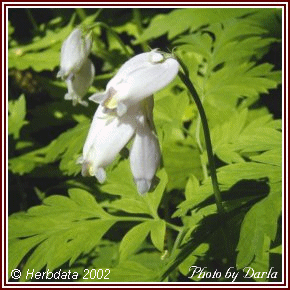

Dicentra eximia, Torr
Common
Names:
Bleedingheart,Turkey Corn, Squirrel Corn, Dutchmans
Breeches, Stagger Weed.
The Eclectic Dispensatory by Prof. J. King, and Prof. L. E. Jones, Materia
Medica, have created much confusion by unfortunately fastening the wrong
name upon this plant. They both call it corydalis formosa, whereas it has
not been known by that name, nor been in that genus, since the works of
Pursh, of more than half a century ago. All standard botanies class it by
the name above given; which will explain to my students in botany why they
can not find in their text-books the corydalis described by Dr. King. The
dicentra as a genus has the marked character of two spurred sepals, while
the genus corydalis has but one prominent feature that
would at once be noticed by any real botanist. This botanical blunder of Dr.
King is the more inexcusable,from the fact that Prof. J. Kost, in his
Materia Medica, correctly discriminated the true genus of this plant, and
showed that it is not a corydalis. The root (small tubers) varies from a
yellowish-white to a dusky color externally, and a lighter yellow
internally. It has a faint smell; and a bitterish, pungent, and rather
persistent taste. Water extracts its virtues very well; but it contains a
resinous substance that is best acted on by alcohol.
Properties and Uses: The roots are stimulating and
moderately relaxing, acting slowly but persistently, and influencing the
secretory organs especially the kidneys and skin. It slowly elevates the
circulation, and gives vigorous action to the entire system; and it is
probably by this action upon the capillaries that it proves alterant. It
does not increase perspiration so as to make it sensible, though evidently
aiding in the elimination of both saline and sebaceous excreta; but the
amount of urine is perceptibly increased after its use, and the solid
elements of this excretion augmented. It stimulates the salivary glands,
fauces, and stomach; and gives a feeling of warmth and excitement to the
stomach and whole system. Yet these impressions are made rather slowly; and
are not so positive as those made by guaiacum. It is suitable for languid
and insensitive conditions; and is among the most valuable agents of its
class for secondary syphilis, where it is most generally prized; and is an
excellent combining agent to give intensity to relaxants in the treatment of
scrofula and scrofulous ulcers, white swellings, herpetic eruptions, and
chronic rheumatism. Thus used, it is even more valuable in the latter forms
of disease than it is in syphilis. It leaves behind a good tonic influence,
mainly through its influence upon the capillary circulation: but it is quite
an error to pronounce it equally tonic with gentiana and frasera. From its
decidedly stimulating character, it should not be used in sensitive and
irritable conditions of the system; and is, at any time, best when combined
with relaxing alteratives in excess. It is seldom used in any other form
than infusion or other pharmaceutical preparation. Half an ounce of the
crushed bulb infused for an hour in a pint of hot water, forms a preparation
of which one to two fluid ounces may be given three times a day.
Pharmaceutical Preparations: Compound Sirup of Dicentra and Alnus. Take four ounces each
of dicentra, alnus, menispermum, and the seeds of arctium lappa. Crush well;
and macerate for two days, in a covered vessel, with a sufficient quantity
of diluted alcohol. Transfer to a displacement apparatus, and add warm water
till a pint of the spirituous tincture passes; which set aside, and continue
the percolation till three pints have been obtained. Evaporate the last
product to two pints, and add two and a half pounds of sugar. When cold, add
the reserved pint of tincture. This is a superior alterative preparation in
secondary syphilis and scrofula. I have used it largely for several years in
syphilis and mercurio-syphilitic difficulties; and always with the most
gratifying results. Dose, half to a whole fluid ounce three times a day.
Abstracted and abridged from:
The Physiomedical Dispensatory by William Cook, M.D., 1869
![]()